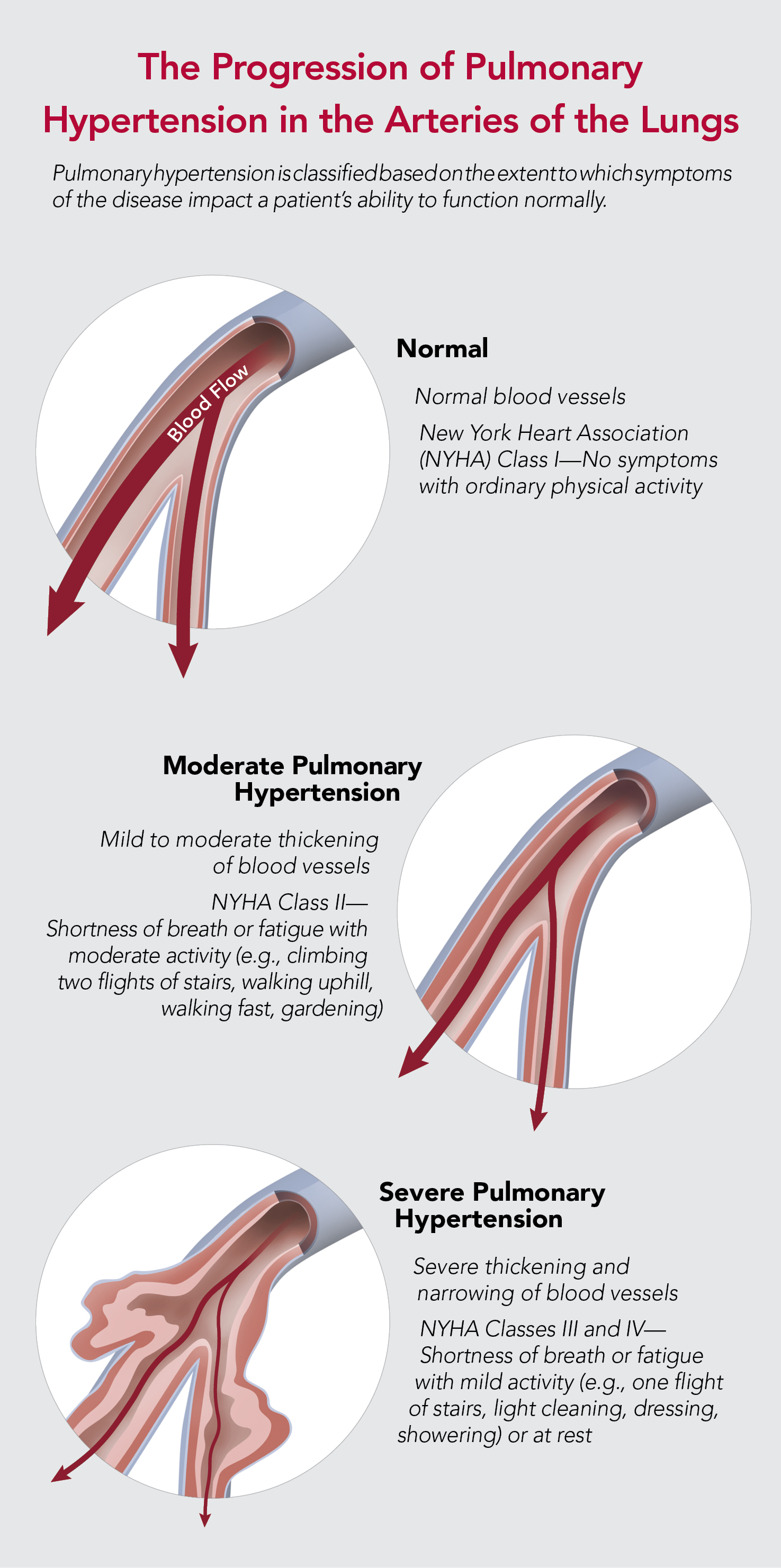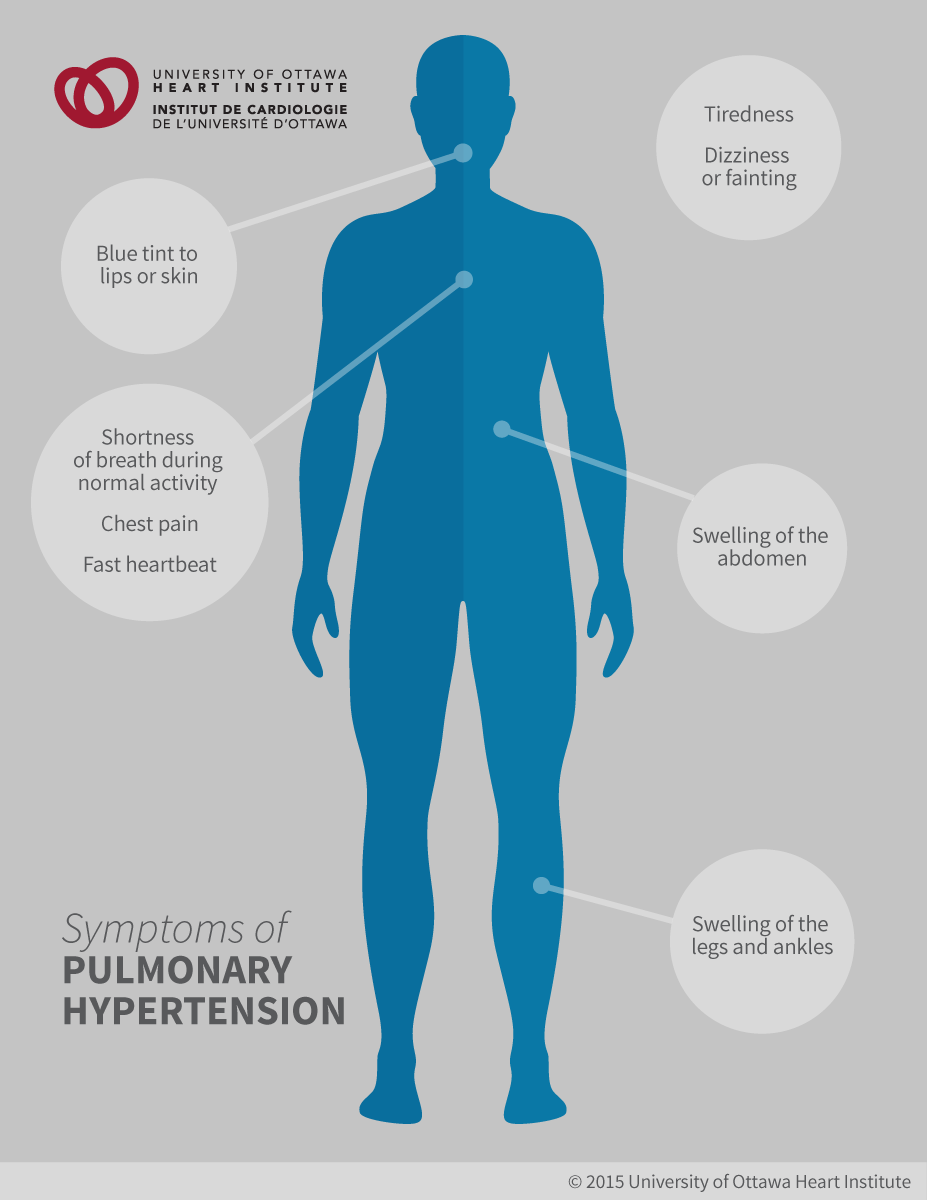
(Click to enlarge)
Pulmonary hypertension is high blood pressure in the arteries in the lungs. The arteries are narrowed which makes it more difficult for blood to flow through. Pulmonary hypertension puts a lot of strain on the right side of the heart causing symptoms such as irregular heartbeat, shortness of breath, dizziness, or heart failure. Pulmonary hypertension is treated with medications and lifestyle changes and, in some cases, surgery.
About Pulmonary Hypertension
The heart is a muscle that pumps blood around the body through a series of tubes called arteries. The left side of the heart receives fresh, oxygen-rich blood from the lungs and then pumps it out to all parts of the body. The right side of the heart gets the blood back from the body and pumps it to the lungs where it picks up more oxygen and the cycle begins again.
Pulmonary hypertension is high blood pressure that occurs in the blood vessels in the lungs. They become narrowed and stiff making it difficult for blood to flow through.
The pressure can be high on the right side – in the blood vessels that bring blood from the heart into the lungs to get more oxygen, or high on the left side – the blood vessels that bring oxygen-rich blood from the lungs back to the heart.
Pulmonary hypertension decreases the amount of blood flow into the lungs. This decrease causes the right ventricle in the heart to pump harder to try to get more blood to the lungs. The right side of the heart (right ventricle) can become enlarged from this extra effort which may lead to heart failure.
On this page
Causes
Many different medical conditions can cause pulmonary hypertension such as:
- Congenital heart disease
- Inherited genetic conditions
- Lung conditions such as chronic obstructive pulmonary disease (COPD) or interstitial lung disease
- Sleep apnea (repeated short stops in breathing during sleep)
- Mitral valve disease, or other diseases affecting the left side of the heart
- Blood clots in the lungs
- HIV infection
- Diseases that affect the blood vessels (vascular disease)
- Sickle cell anemia
- Use of cocaine or other street drugs, or some diet drugs such as Fen-Phen
- Emphysema, which is often caused by smoking
- Cardiomyopathy
In rare cases, the cause of pulmonary hypertension cannot be determined. This is called idiopathic pulmonary hypertension.
Diagnosis
The most common tests used to diagnose pulmonary hypertension include:
- Echocardiogram: to determine if there is high pressure in the lungs
- Electrocardiogram: to identify problems with heart rhythm
- Chest X-rays: to check the size of the blood vessels in the lungs
- Cardiac catheterization: to identify if the high pressures are in the right side of the heart or left side of the heart
- Six-Minute Walk Test: to see how far a patient can walk in six minutes and how short of breath and tired they feel
Other testing may be done to determine the underlying cause of pulmonary hypertension.
These tests include:
- Pulmonary function testing: to identify possible damage to the lungs from diseases such as emphysema
- Ventilation-perfusion (V/Q) scan: to look for blood clots
- Computed tomography (CT) scan: to look for physical changes in the heart and lungs
- Sleep study: to check for sleep apnea
- Blood tests: to measure oxygen levels and to check for other causes
Symptoms
Many symptoms of pulmonary hypertension can easily be confused with common conditions such as asthma.
Symptoms of pulmonary hypertension can include:
- Shortness of breath during exertion such as walking up a flight of stairs or during normal activity
- Tiredness
- Dizziness or fainting
- Chest pain
- Swelling in the ankles, legs, or abdomen
- Fast heartbeat
- A blue tint to the lips or skin
Treatments
Treating pulmonary hypertension often requires a variety of approaches. Usually people with pulmonary hypertension are sent to specialists who can make the best recommendations for care depending on the specific patient.
Medications
Commonly used treatments for pulmonary hypertension include medications that dilate (open) the blood vessels so the heart can pump easier. These medications work to:
- Stop the narrowing of the blood vessels (e.g., endothelial receptor antagonists and PDE5 inhibitors)
- Relax the blood vessels (calcium channel blockers)
- Prevent blood clots, such as the blood thinner warfarin
- Remove excess fluid in the body (diuretics)
- Help the heart pump more blood (digoxin, also known as digitalis)
Many different types and classes of medications are available for reducing the symptoms of pulmonary hypertension. Not all medications will work for all patients; it depends on the underlying cause. A patient may need to try several different medications before finding one that works for them.
Oxygen Therapy
Some patients with pulmonary hypertension may need to breathe pure oxygen through an oxygen mask or though tubes that fit into the nose. Breathing pure oxygen can help relieve shortness of breath and can reduce blood pressure in the pulmonary arteries.
Surgery
Some causes of pulmonary hypertension can be treated with surgery. If a blood clot in the lungs causing pulmonary hypertension does not dissolve on its own, a type of surgery called pulmonary thromboendarterectomy may be used to remove the clot(s).
Sometimes, a patient with severe pulmonary hypertension who no longer feels better with medications and is short of breath at rest may receive a lung transplant or a heart-lung transplant. These procedures can be performed only in patients who are healthy enough to undergo major surgery.
Lifestyle Changes
Although patients with pulmonary hypertension may find exercising difficult, some patients find that light exercise helps relieve their symptoms. Patients considering beginning an exercise program should consult with their doctors before changing their level of physical activity.
Quitting smoking can help with lung function in general and can specifically help relieve symptoms of pulmonary hypertension. Smoking-cessation aids are available to patients who find it difficult to quit on their own.


